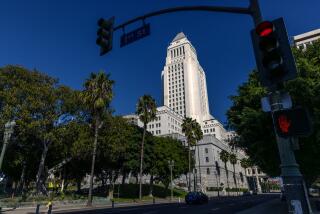Panel Issues Opposing Reports on Cameras in Court
SAN FRANCISCO â A state task force appointed to study courtroom cameras was so divided about banning them from all criminal pretrial proceedings that panelists decided to issue a minority and a majority report, the chairman of the panel confirmed Monday.
The majority report to the California Judicial Council recommends barring cameras from the pretrial proceedings and those portions of trials in which the jury is not present.
A minority report asks the council, the state policymaking body for the courts, to ban cameras only from arraignments, bail hearings and trial proceedings that exclude jurors.
The Judicial Council will decide which course, if any, to approve at a meeting Friday. Gov. Pete Wilson, who has called for a ban on cameras, asked the council to examine the debate after the O.J. Simpson verdict.
A source familiar with the deliberations said members who signed the minority report expressed concern that a complete camera ban on portions of cases not witnessed by jurors would infringe too much on judicial discretion.
âWe had an honest disagreement among the task force members,â said Court of Appeal Justice Richard D. Huffman, who presided over the task force. âBoth interests, the minority and the majority, are concerned about balancing the interests of the public to have access to these proceedings, against concerns about prejudice to the rights of parties in criminal cases.
âAnd reasonable people will disagree as to where to strike that balance,â he said.
Three of the task forceâs 13 members signed the minority report, Huffman said. The task force, appointed by former state Supreme Court Chief Justice Malcolm Lucas before his retirement last month, consists of nine judges, two court administrators, a public defender and a district attorney.
The group made a preliminary report to the Judicial Council in February and revised its recommendations after receiving more public comment. The new report suggests that a judge may bar cameras from a courthouse, including its front steps, but clarifies that jurists cannot prevent cameras operating from a sidewalk in front of a courthouse or across the street.
âWe donât want to infringe on 1st Amendment rights,â Huffman said. âAt the same time, trial courts ought to be able to control the activity in the hallways.â
The task force also tinkered with a provision that required news media members to apply to have a camera in a courtroom five days before a proceeding. Exceptions will be made in cases in which the media learned of a case fewer than five days before it started, a knowledgeable source said.
The source said the entire task force agreed that allowing cameras to record arraignments or bail hearings could jeopardize later trials if eyewitness identification is significant in the case. Often, a judge does not know enough about a case during the arraignment or bail hearing to make an informed judgment about cameras, the source said.
Huffman downplayed the divisions within the task force, insisting that there was ânot a big war.â He said he will present both reports to the Judicial Council, which is headed by state Supreme Court Chief Justice Ronald M. George.
Judges now have the authority to decide whether to permit cameras, including still photography. The state Assembly voted overwhelmingly last month to continue to give judges such discretion, but Gov. Wilson is expected to veto any such legislation. News media representatives have been lobbying against the proposed ban.
More to Read
Sign up for Essential California
The most important California stories and recommendations in your inbox every morning.
You may occasionally receive promotional content from the Los Angeles Times.











